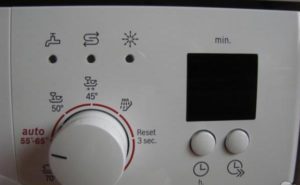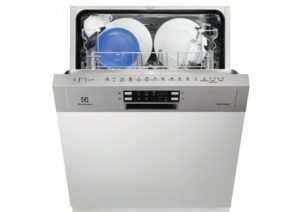Dishwasher diagnostics
 When a dishwasher breaks down, it’s always unpleasant, because you quickly get used to something good and don’t really want to wash dishes by hand. There is a desire to quickly fix the “iron assistant”, and ideally without spending a penny on it. Where to begin? Well, of course, from diagnosing the car and troubleshooting. In essence, diagnostics are largely carried out by the dishwasher on its own; the main thing is to be able to understand its actions and draw the right conclusions. This will be discussed in the article.
When a dishwasher breaks down, it’s always unpleasant, because you quickly get used to something good and don’t really want to wash dishes by hand. There is a desire to quickly fix the “iron assistant”, and ideally without spending a penny on it. Where to begin? Well, of course, from diagnosing the car and troubleshooting. In essence, diagnostics are largely carried out by the dishwasher on its own; the main thing is to be able to understand its actions and draw the right conclusions. This will be discussed in the article.
Can a dishwasher help you find a problem?
The manufacturer made sure in advance that the dishwasher itself could detect faults and tell the consumer about it. The control module contains a special software algorithm that allows, if any failures occur, to immediately identify it and display it on the display screen in the form of a specific code.
For your information! If the dishwasher does not have a display, then information about the malfunction is displayed using indicators illuminated in a certain order.
The self-diagnosis program is well developed in dishwashers:
- Bosch,
- Electrolux,
- AEG,
- Miele,
- Ardo,
- Ariston,
- Beko and others.
In this article, we will look at how diagnostics are carried out in Bosch and Electrolux machines. The principle of error recognition is approximately the same for everyone, but the depth of analysis and accuracy of fault determination depends on the brand, model, generation of the control module and many other factors. But one thing is for sure, all modern dishwashers have a self-diagnosis system, and it brings great benefits to both users and experienced professionals.
The most common faults and their codes
Most of the fault codes for Bosch or Electrolux dishwashers are designed for fairly rare breakdowns, you are unlikely to encounter them, but some occur all the time, we will pay special attention to them. The following common errors are inherent in the Bosch dishwasher.
- The pumped water remains cold - error code E1.
- There are problems with the pressure switch - error code E2.
- There is too much water in the dishwasher - error code E5.
- The aqua sensor is out of order - error code E6.
- The heating element has failed - code E9.
- The Aquastop system has worked or broken down, a blockage has formed in the system - code E15.
- No water flows into the Bosch dishwasher - code E17.
- The pump does not work at all or does not function normally - codes E21, E24.
- Low voltage in the electrical network - code E27.
Actually in the memory of the dishwasher Bosch has many more errors and, accordingly, codes for them; if we take the most modern models, they are able to recognize more than 200 different breakdowns. But the most relevant are still the above errors. Electrolux does not lag behind its direct competitor Bosch, constantly improving the self-diagnosis system of its dishwashers. Here are the common Electrolux dishwasher error codes.
- Problems with water flow into the dishwasher – the END indicator + code i will blink once
- It is difficult or absent to drain water into the sewer - the END indicator + code i will blink 2 times
- The system preventing water from overflowing into the dishwasher has activated - the END indicator + code i will blink 3 times
- The water is not heated properly or not at all – the END indicator + code i will blink 6 times
- There is a blockage somewhere in the system - the END indicator + code E20 will blink 2 times.
Important! The letters in front of the digital error code will depend on the model of the Electrolux dishwasher, see the instructions.
About troubleshooting and troubleshooting
We talked in general terms about the self-diagnosis system of Bosch and Electrolux dishwashers. We have indicated the most common error codes, now we just have to decipher these errors and outline ways to eliminate them. For the purposes of this story, we will do this as an overview, but if you want more detailed information about a specific error, please visit other pages on our site. In particular about error E24 on a Bosch dishwasher you can read in the article of the same name.
Errors E1, i60. These system errors tell the user and the technician that the heating element or its electrics are faulty in the dishwasher. First you need to try running different washing programs.
If the heating element does not work in all programs, then you will have to disassemble the dishwasher and check the unit with a multimeter. A value within 1500 Ohms indicates that the unit is working; if it is much less, it means that the heating element will have to be changed.
E2 and i30. If the machine produces such errors, it means that there are certain problems with the water level sensor. Perhaps the sensor itself is working, but the contact is faulty, which cuts off its power supply; it is difficult to say for sure until you look at this part with your own eyes and are convinced. Sometimes it’s enough just to blow out the pressure switch and everything will work, but sometimes the sensor needs to be replaced.
Note! Hard water has a destructive effect not only on the filters, pump or circulation pump, but also on the pressure switch, so do not be surprised that limescale may remain on this sensor.
E21, E24 and i20. These errors “pop up” when it comes to any problems with draining water. In this case, the operating mode of the dishwasher does not matter. The pump may not work, or it may be fully operational, but it will not be able to pump out water, for example, due to a pinched hose, a clogged filter, or for some other reason. Again, you will have to perform a series of actions described in detail in the article The dishwasher does not drain water - what to do??
E15 and E20. These codes indicate 2 categories of errors, different in nature, but identical for the dishwasher in terms of recognition features - clogged and activated Aquastop. Why are these errors the same from a recognition point of view?
- In both cases, water cannot get into the dishwasher.
- In both the first and second cases, the control module regularly issues the command to fill with water, but receives the same response from the pressure switch.
- In both cases, the water path becomes clogged. Only in the case of Aquastop, the path closes emergencyly using a valve - this is due to the mechanism. If a blockage occurs, the tract becomes blocked spontaneously with the help of compressed dirt or lime deposits.
The problem is solved quite simply. If the Aquastop hose has worked, it must be replaced with a new one; the old one cannot be repaired. In the case of a blockage, both chemical and traditional cleaning - with your own hands - will help.
To summarize, we note that the primary diagnosis of the operation of a dishwasher “lies on the shoulders” of the dishwasher itself. The manufacturer tried to ensure that in case of almost any breakdown, the machine itself could tell the user what was wrong, thereby making his life much easier!
Interesting:
Reader comments
- Share your opinion - leave a comment
Categories
Washing machine repair


For buyers

For users

Dishwasher

















Add a comment